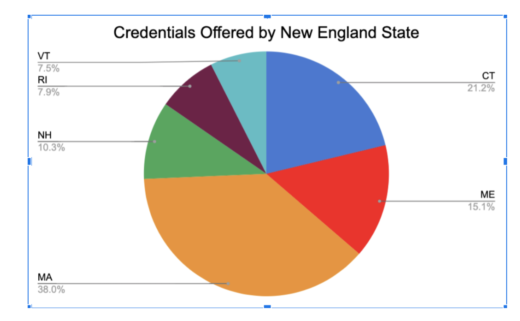 NEBHE offers a regional analysis of national Counting Credentials report …
NEBHE offers a regional analysis of national Counting Credentials report …
The U.S. is in the midst of one of the most severe economic recessions in history, and now more than ever, it is important to acknowledge all possible pathways to gainful employment. On Feb. 10, 2021, Credential Engine released its third Counting Credentials report, which compiled and described the array of available credentials in U.S. secondary and postsecondary educational institutions.
Credential Engine aims to bring transparency to all credentials, and to publicize a marketplace of these credentials to help students understand their options, help employers see the most valuable credentials for their industry, and help policymakers best tackle the education and employment gaps and disparities which, though present before 2020, have been deepened by the coronavirus pandemic. In its report, Credential Engine curated a list of 967,734 unique credentials—an increase of 31% from the 738,428 credentials published in its 2019 report.
Credentials are essentially certifications of academic completion. In higher education, the most common academic credentials are associate, bachelor’s and graduate degrees. The lesser-known credentials are among the ones that Credential Engine strives to bring attention to so that students can understand all their options outside“traditional” higher education. This also benefits employers, who, if they know their options, can hire from another, and perhaps more industry-specific, workforce pool both within and outside college graduates.
Moreover, as we attempt to increase diversity, equity and inclusion in hiring practices and higher education more generally, it is imperative to understand and recognize nontraditional credential pathways.
The latest Credential Engine report uses something called Credential Transparency Description Language (CTDL) that allows people to make “apples-to-apples” comparisons between credentials to access training opportunities in specific fields. The report breaks down the credentials into four categories: postsecondary institutions credentials, massive open online course (MOOC) provider credentials, credentials from non-academic providers, and credentials from secondary schools. The national and regional breakdowns can be found below.
National findings
The report detailed 967,734 unique credentials offered across the four aforementioned fields. Nationally, in 2020, postsecondary institutions offered 37% or 359,713 credentials, represented through completion of both Title IV and Non-Title IV degrees and certificates. MOOC providers, which offer both academic degrees and microcredentials fully online, offered 1% or 9,390 credentials through microcredentials, degrees from foreign universities, and course-completion certificates. Non-academic organizations made up the majority of the credential count with 57% or 549,712 credentials represented across occupational licenses, occupational certificates, registered apprenticeships, unregistered apprenticeships, unregistered apprenticeships, online course completion certificates, and digital badges. Lastly, secondary schools represented 5% of the credential count with 48,909 credentials represented through the dissemination of public and private school diplomas. (For definitions of the various credentials, refer to the p. 21 of the report.
Regional findings
The pie chart below indicates the breakdown of credentials offered across all fields by New England state. As you can see, Massachusetts offers the majority of credentials across all six states, which makes sense as it also has the largest number of postsecondary institution in the region. For specific numbers of credentials, refer to the chart below.

The report also broke down the exact number of credentials, measuring the number of degrees, certificates, apprenticeships, licenses and high school diplomas for each state. Of the 967,734 credentials published, New England accounted for 25,356, or 3% of all U.S. credentials offered by regional institutions or programs. Refer to the graph below for the disaggregated New England findings.

This report indicates despite a wide breadth of credentials offered in our country, we have much work to create greater credential transparency for students and employers alike. This is why NEBHE is working with Credential Engine to implement the High Value Credential Project. High Value Credentials for New England (HVCNE), our Lumina Foundation-funded program that provides individuals, institutions, state policy leaders and employers with the tools to use common language to catalogue and compare credentials, interpret credential quality, identify critical education, training and employment pipelines, and understand the skills and competencies obtained while earning a credential. Through this initiative, NEBHE hopes to make our regional population more aware of all of their options for higher education and credential completion, and help New England employers make the most informed decisions by providing an in-depth look at the kinds of credentials New England residents are gaining.
If you have any questions, or would like to browse the credential registry to learn more about this project, refer to NEBHE’s website here. In order to learn more about Credential Engine and its annual data, refer to the report here.
Sheridan Miller is coordinator of state policy engagement at NEBHE.
[ssba]
